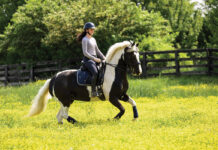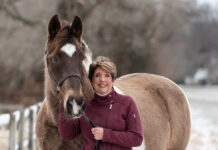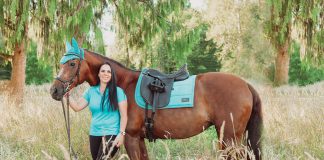
The forest is thick with lanky Aspens, shimmering birch trees, wild cranberry bushes and cottonwoods with gray bark furrowed like snow tires. Emerald moss clings to crumbling logs.
Down the hill through the trees I see the sparkle of Lake Matanuska, full of arctic char and silver salmon. I’m on a big, steady sorrel Tennessee Walking Horse named Cache of Class, or just “CC” for short. She’s the perfect candidate to show me Alaska (and the smooth ride of a gaited horse) on a remarkably perfect day.
When the invitation came for me to visit Palmer, Alaska and ride its surrounding backcountry, I jumped at it. The area is home to the remarkably beautiful Knik (pronounced ka-NICK) Glacier. The mountains, the horses and the chilled temperatures of Alaska beckoned. It had been a really hot summer where I live in Washington, D.C. I booked a flight immediately.
Arriving in Alaska felt something like arriving in a different world. The air was different. I felt a current run through me as I studied the massive mountains on the 45-minute drive north east to Palmer—massive rocky mountain faces capped with snow and, down below, ragged tree tops in browns and burnt umber.
Prepared for Anything
Later that week, when we rode the sandy brown riverbed that leads to the glacier, I felt the same electricity in the air as when I first arrived. It was spooky riding through the backcountry. It’s completely off the grid and filled with wildlife, like brown bears and wolves.
We took precautions. Some riders carried bear spray. And, especially when we rode near noisy, running water, in dense woods, and when the wind was strong, we yelled, “Coming through!” to let the bears know we were there. Bears don’t like surprises. They also don’t like humans and remain unseen most of the time.
In addition to black bears and wolves, the area is home to lynx, wolverines (remarkably tough little animals that look like bears but are actually a very large weasel-type animal) and moose. Very large moose. These animals can weigh as much as 1,500 pounds and stand 7 feet high at the shoulder.
That day, riding toward the glacier—it appeared like a strip of ice glowing blue in the distance—most of the wildlife remained invisible, as it did throughout most of my trip. The Walking Horses frisked and flat walked in the cool temperatures.
I rode in an Alaskan-made riding skirt that kept my legs warm and dry, even when it rained or when the horses splashed through creeks rushing with snowmelt. Bald eagles soared overhead and a flock of trumpeter swans with 8-foot wingspans crossed the riverbed above our heads.
With no roads or marked trails, few people make it out to this remote backcountry. There’s nothing but wilderness (and GPS coordinates) for hundreds of miles.
Beware the Moose
During another ride, we saw a gigantic bull moose pretty close up. He had antlers stretching out over his head wider than I am tall. These animals seem serene but can be aggressive, especially during the rutting (or mating) season. This one was courting a cow. The horses were on high alert.
We took the potential danger seriously. It was not a good time for iPhone moose videos, however tempting. We waited to see which direction the animals would go. After the bull followed the cow into the woods, we moved along in the opposite direction.
Seeing moose is an everyday thing for my Alaskan horse friends. But for me it was beyond special. I board my horse and ride in an area that’s more suburban than rural. That day, I was grateful to be in the wilderness, grateful for the existence of the wilderness and so happy to be among rugged horse lovers who shared their magical, snow-capped and wild world with me.
Polar Horsekeeping
My host in Alaska, Jen Garner, is a marine biologist in addition to running the B&B where I stayed (www.buttesbethel.com). In 2016, she founded ArcticHorseGear.com. She grew up in Vermont, riding and caring for homebred Morgan horses. In those days, blanket changes for different temperatures in the chilly Northeast dominated the winter care routine for the horses.
Over the years, Jen has simplified her approach despite living in a severe winter climate. In Alaska, the stakes are high when it comes to properly caring for domestic animals that live outside. The danger of cold, wind and wet is extreme.
Here are a few critical success factors Jen keeps in mind to keep her horses—an Appaloosa named Falybe and two Tennessee Walking horses named Sambatara and Willow, healthy and comfortable during Alaska winters where temperatures often dip to 20 degrees below zero.
Shelter: Jen’s hardy, furry horses live in a large, alpine paddock with a well-used open-air shelter made from logs found on the property. She focuses on making sure the horses’ coats stay dry enough to trap air, which their body heat then warms. When it’s rainy, the horses may wear sheets or blankets. Inside the shelter they have a heated water trough.
24-hour access to forage: “In this climate, I make sure my horses have access to quality hay all the time.” Hay digestion, she says, works like a combustion engine that creates heat from the inside. Her horses each eat about 25 pounds of hay a day, and more in the winter. Jen says they tend to bulk up at the end of the summer.
Frequent monitoring: Jen’s horses, who live not far outside the back door of the log cabin she shares with her husband, Chris, and their dogs, are closely watched. But even if it’s super cold, the horses tend to do just fine without extra care. “It depends on the individual horse and the conditions,” she says. “I’ve been around horses in many different climates, and these are the happiest horses I’ve ever known.”
This article originally appeared in the October 2017 issue of Horse Illustrated magazine. Click here to subscribe!






